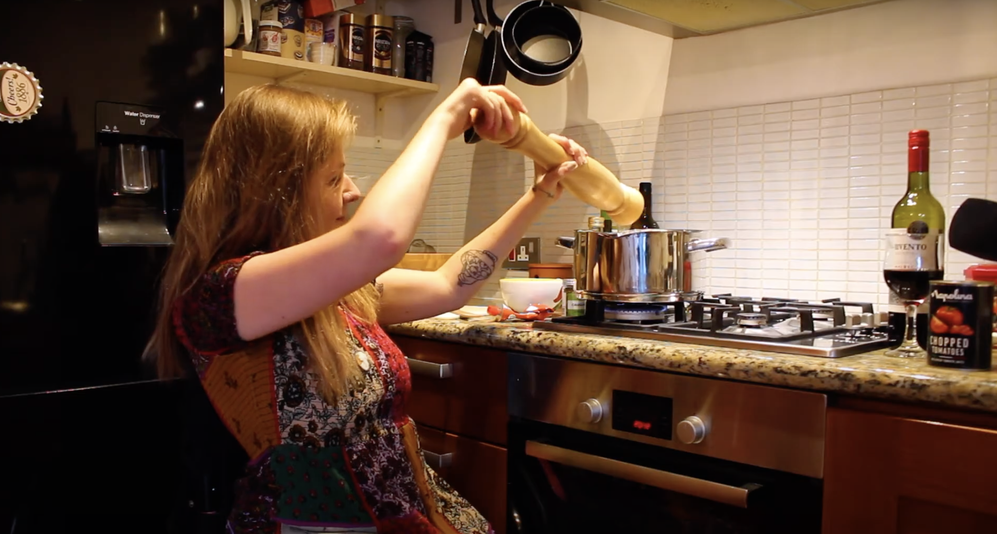[embedded content]
Cheese, joy, and an inordinate amount of garlic are just a few things in abundance in the new YouTube cooking show Cooking in a Wheelchair.
The idea to make an accessible cookery show came during lockdown when disability campaigner Katie Pennick was shielding at home for three months, and unable to leave the house for any reason. Prior to the pandemic, Pennick tended to eat out quite often. So when she began shielding, she got stuck into cooking every day out of sheer necessity in addition to keeping herself busy.
Pennick, who uses a wheelchair, is frustrated with how people with disabilities are represented on television, films, and in the media. “Every time that there is a show that explores disability or has a disabled character in it, it usually falls into several different tropes,” she told me. Pennick explained that one of the frequent tropes in media portrayals is a person “overcoming” their disability — terminology that she hates. Then there’s “inspiration porn,” which Pennick describes as “oh, this poor woman is in a wheelchair, but look, she can still make pasta.”
“What we don’t see is disabled people just living and doing something that’s completely unrelated,” she said. “I don’t ever really see disabled people on a cooking show, cooking, and talking about cooking, or gardening, painting, or something completely neutral.”

Image: katie pennick
Enter Cooking in a Wheelchair, Pennick’s one-woman cooking show, which you can watch now on YouTube. Filmed, edited, and presented by Pennick, the show features simple, low-energy recipes that require minimal chopping and “faffing,” as the host describes it.
The first episode shows you how to make a simple dish of gnocchi in a garlicky tomato and mozzarella sauce, and throughout the process, Pennick discusses accessible cooking techniques, gadgets, and tricks she’s picked up. “As a disabled person, you don’t have anyone to look to or learn from and no one hands you a book and says, ‘This is how you do things,'” she told me. “You just have to figure things out and I worry that a lot of disabled people probably think that they can’t cook because things haven’t been made accessible for them.”
Simple, low-energy recipes that require minimal chopping and “faffing.”
Through the cooking show, Pennick wants to show an alternative way of doing things. “A lot of people cook at these beautiful islands in their kitchen where they’re stood up at high counters, but that’s not that’s not what cooking has to be,” she said. “You can cook sitting down at low tables, you can take your time doing it, not everything has to be rushed, you can have assistance doing things, you can buy products and energy-saving gadgets, and also products where things are chopped for you.”
As a wheelchair user, Pennick is conscious that her experience does not speak for everyone. At the start of the episode, she caveats that she is not an occupational therapist or a doctor. “Obviously I can only speak from my experience as a wheelchair user. It’s a very different set of situations and circumstances if you have chronic fatigue or if you are visually impaired,” she told me. “I’m hoping that people will share their own kind of tips and tricks.”
So, how did Pennick go about choosing which recipes to include? “I’ve chosen some recipes that are, in my opinion anyway, fairly low effort or energy,” she said. “So they are recipes that are either simple to follow, and not many steps, or they are recipes that don’t have too many laborious physical activities involved.”
Pennick includes grating and mashing, as well as chopping hard vegetables like carrots and potatoes, in those types of energy-sapping tasks, so she’s going to avoid including recipes with those movements.
“I’m a big fan of like one-pot recipes or like things that you can just chuck things into one pot, which saves washing up, which is obviously another huge part of the kind of energy-sapping thing,” she added. In the video, Pennick also explains that she sets up an area at a low table where she does all her cooking prep, and she doesn’t move from it throughout the process. So, she’ll make sure she has a pot to keep any waste for the bin, and ensure she has all the utensils and ingredients set up before she gets started. “It saves me from moving around the kitchen because it’s very difficult to push a wheelchair and carry things at the same time,” she explained.
Cooking in a Wheelchair is a joy to watch because Pennick is relaxed, funny, and clearly just enjoys cooking. And this joy is actually quite an important element in how Pennick considers accessibility. “When we talk about access, we talk about very fundamental things, like infrastructure, transport, and public services and things like that. But it’s also about access to joy, and access to life and cooking is very much a part of that.”
Pennick succeeds in presenting a cooking show that is devoid of the overused tropes about people with disabilities. She is not “overcoming,” or “working around,” or even providing “inspiration.”
“Being disabled is not a bad thing. It’s not a negative descriptor. I don’t need to overcome it. I don’t need to be better than it. I don’t need to find a workaround,” she said. “I’m disabled, that is a part of my identity. It’s just a part of who I am. I’m very proud of it.”
Episode 1 of Cooking in a Wheelchair is available on YouTube now. Pennick will upload new episodes whenever she can.
